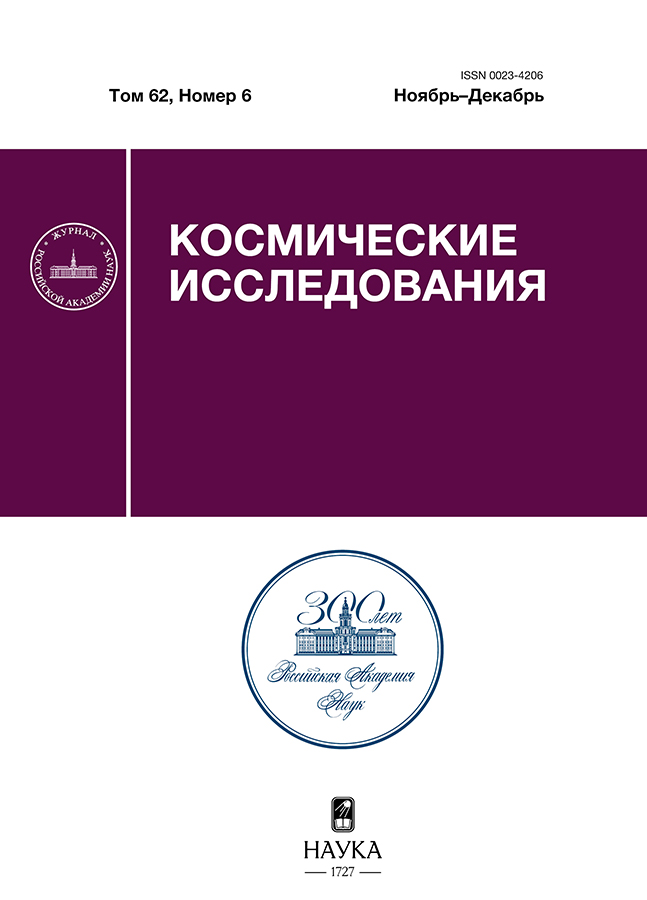Научные задачи и перспективы комплекса плазменных приборов в проекте Венера-Д
- Authors: Моисеенко Д.А.1, Вайсберг О.Л.1, Петух А.И.1, Журавлев Р.Н.1
-
Affiliations:
- Институт космических исследований РАН
- Issue: Vol 62, No 6 (2024)
- Pages: 655-662
- Section: Articles
- URL: https://kazanmedjournal.ru/0023-4206/article/view/672792
- DOI: https://doi.org/10.31857/S0023420624060098
- EDN: https://elibrary.ru/IFIEVS
- ID: 672792
Cite item
Abstract
В статье рассматривается перечень актуальных научных задач, которые позволит решить плазменный комплекс приборов на борту космического аппарата Венера-Д, а также описывается структура и принцип функционирования трех плазменных приборов: ионного энерго-масс анализатора, электронного энерго-анализатора и детектора энергичных нейтральных атомов.
Full Text
About the authors
Д. А. Моисеенко
Институт космических исследований РАН
Author for correspondence.
Email: modaldi@cosmos.ru
Russian Federation, Москва
О. Л. Вайсберг
Институт космических исследований РАН
Email: modaldi@cosmos.ru
Russian Federation, Москва
А. И. Петух
Институт космических исследований РАН
Email: modaldi@cosmos.ru
Russian Federation, Москва
Р. Н. Журавлев
Институт космических исследований РАН
Email: modaldi@cosmos.ru
Russian Federation, Москва
References
- Russell C.T., Vaisberg O. In Venus / ed. by Hunton D.M. et al. Univ. of Arizona Press, Tucson, 1983. P. 873–94.
- Zelenyi L.M., Malova H.V., Artemyev A.V. et al. Thin current sheets in collisionless plasma: equilibrium structure, plasma instabilities, and particle acceleration // Plasma Phys. Rep. 2011. V. 37. P. 118–160. doi: 10.1134/S1063780X1102005X
- Vaisberg O.L., Zeleny L.M. Formation of the plasma mantle in the Venusian magnetosphere // Icarus. 1984. V. 58. P. 412–430. doi: 10.1016/0019-1035(84)90087-3.
- Barabash S., Fedorov A., Sauvaud J.J. et al. The loss of ions from Venus through the plasma wake // Nature. 2007. V. 450. P. 650–653. doi: 10.1038/nature06434
- Futaana Y., Stenberg Wieser G., Barabash S. et al. Solar Wind Interaction and Impact on the Venus Atmosphere // Space Sci. Rev. 2017. V. 212. P. 1453–1509. https://doi.org/10.1007/s11214-017-0362-8
- Вайсберг О.Л., Журавлев Р.Н., Моисеенко Д.А. и др. Широкоугольный ионный энерго-масс-анализатор АРИЕС-Л // Астрономический вестник. 2021. Т. 55. № 6. С. 575–588. doi: 10.31857/S0320930X21060116
- Orsini S., Livi S.A., Lichtenegger H. et al. SERENA: Particle Instrument Suite for Determining the Sun-Mercury Interaction from BepiColombo // Space Sci. Rev. 2021. V. 217. Iss. 11. https://doi.org/10.1007/s11214-020-00787-3
- Wieser M., Barabash S., Wang X.-D. et al. The Advanced Small Analyzer for Neutrals (ASAN) on the Chang’E-4 Rover Yutu-2 // Space Sci. Rev. 2020. V. 216. Iss. 73. https://doi.org/10.1007/s11214-020-00691-w
- Wurz P., Wieser M. Production of a 10 eV–1000 eV neutral particle beam using surface neutralization // Meas. Sci. Technol. 2005. V.16. P.2511–2516. doi: 10.1088/0957-0233/16/12/016
- Niehus H., Heiland W., Taglauer E. Low-energy ion scattering at surfaces // Surface Science Reports. 1993. V. 17(4–5). P. 213–303. doi: 10.1016/0167-5729(93)90024-j
- Young D.T., Burch J.L., Gomez R.G. et al. Hot Plasma Composition Analyzer for the Magnetospheric Multiscale Mission // Space Science Reviews. 2014. V. 199(1–4). P. 407–470. doi: 10.1007/s11214-014-0119-6
- Halekas J.S., Lin R.P., Mitchell D.L. Large negative lunar surface potentials in sunlight and shadow // Geophysical Research Letters. 2005. V. 320(9). doi: 10.1029/2005GL022627
- Wurz P., Scheer J., Wieser M. Particle Scattering off Surfaces: Application in Space Science // e-Journal of Surface Science and Nanotechnology. 2006. V. 4. P. 394–400. doi: 10.1380/ejssnt.2006.394
- Моисеенко Д.А., Вайсберг О.Л., Митюрин М.В. и др. Масс-анализатор ионов солнечного ветра ПИПЛС-Б для проекта “ИНТЕРГЕЛИОЗОНД” // Приборы и техника эксперимента. 2019. № 5. С. 96–99. doi: 10.1134/S0032816219050227
- Bhardwaj A., Barabash S., Futaana Y. et al. Low energy neutral atom imaging on the Moon with the SARA instrument aboard Chandrayaan-1 mission // J. Earth Syst. Sci. 2005. V. 114. Iss. 6. P. 749–760. doi: 10.1007/BF02715960
Supplementary files













